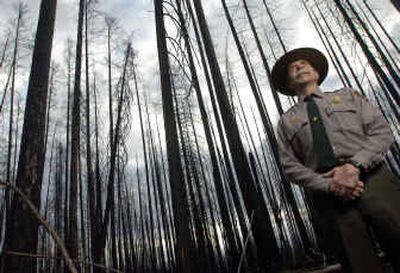Officials see dearth of fire managers

BILLINGS – Wally Bennett remembers how it once was – going for eight, maybe 10 days on a fire assignment, then coming home with the battle won and much of the summer left.
But in recent years, with the Western fire season becoming longer and the fires more intense, the demand for specialized incident management teams like his has grown, and so have the demands on team members.
“And that gets to be quite a burden on the people,” said Bennett, 58, who juggles his duties as an incident commander for one of the nation’s 17 Type 1 teams with a state job in Kalispell. “It’s a major impact on your family.”
Federal fire officials say it’s getting harder to find experienced fire managers like Bennett who are willing to drop everything on a couple hours’ notice to serve on the highly skilled teams used to confront the nation’s most complex blazes. Retirements, disinterest and increased responsibilities at home and work are shrinking the number of people able, or willing, to work with top-level incident management teams.
There are fewer of those teams now than 15 years ago – in spite of increased demands for them for fires and other emergencies – and serious questions about the future of fire management, officials say.
“Certainly, standing still isn’t an option,” said Tom Harbour, the director of fire and aviation for the U.S. Forest Service.
An interagency report released earlier this year recommends, among other things, creating full-time small teams focused on incident management – to ease the strain on the existing teams – and requiring federal land agency workers to get involved in fire management efforts. That was the expectation when guys like Mike Lohrey started out over 30 years ago. And while that expectation is still found in agency manuals, it isn’t being enforced, the report said.
“We have to get back to saying, ‘This is part of our duties,’ ” said Lohrey, who’s with the U.S. Forest Service in Oregon and was part of the group that wrote the report for the National Wildfire Coordinating Group. The work would expose more people to fire culture, he said, and help bring up future incident management officials.
The report said there is a “skill gap” of workers ready to assume high-ranking incident management roles. It also cited a 2003 survey of upper-tier incident management teams – area command, Type 1 and Type 2 teams – that indicated the majority of members would need to be replaced in the next few years. Some of those gaps are now filled by retirees.
Type 1 incident command teams carry about 30 members, including experts on planning, logistics, safety and finance. The teams take turns being on-call for complex wildfires and other emergencies, like hurricane relief, and need to be packed and ready to roll within two hours.
Getting qualified to be part of a team takes years – sometimes the better part of a career.
When Steve Frye began his firefighting career in 1966, he considered a 2,000-acre fire a big deal. But over the years – and particularly in the past few – the fires have gotten larger and more complex, threatening communities and housing developments.
Frye, who led a Type 1 team for nine years, saw both sides of the fight in the summer of 2003. While he was managing fires – and the armies of personnel fighting them – a fire at Glacier National Park was threatening his own family’s home.
“I had great confidence in the teams here, but I can assure you, it was a very intense time for me,” said Frye, the park’s chief ranger.
Frye stepped down as incident commander after last season, making way for another leader whose tenure Frye says may be cut short by work obligations.
Incident management teams are not full-time jobs, though some years, it can certainly seem that way to members like Phil Perkins. According to the report, the number of assignments for individual management teams grew from an average of 2.5 before 1994 to 5.3 assignments in 2003. Non-fire events such as hurricane relief and the recovery of the shuttle Columbia have also demanded the teams’ attention.
Perkins, the fire management officer at Yellowstone National Park, said he missed his kid’s first day of school when he was dealing with the 1988 fires in the park, and his assistant had to pick up some of his park duties over the course of four, more recent, busy summers.
But, he said, he likes the action and challenge that come with being on a Type 1 team. “It’s a lot more fun than the day-to-day work on the homefront, to be quite honest.”
Officials said the recommendations in the incident management report are meant to ease the burden on the current teams – in often-heavy rotation – and make the response system more effective. Representatives from the Forest Service, National Park Service, Bureau of Land Management, U.S. Fire Administration and Alaska Division of Forestry helped develop the report.
A team of fire officials is planning to meet to begin looking at how the report’s recommendations can be implemented. A report from the task group is expected this fall.
To be decided is whether current management teams will be replaced by the seven, full-time teams of incident management experts proposed in the study, and just how quickly those changes could occur. Other recommendations included more streamlined training; reduced reliance on retirees; and more Type 3 teams for quick response to more localized incidents.